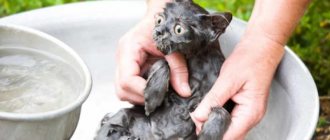Why do you need to bathe your cat?
Before you figure out how to wash a cat, let me tell you why the fluffy cat actually needs to take a bath. It would seem that cats are very clean creatures that can wash themselves. In fact, body hygiene is one of purrs’ favorite activities (besides sleeping and dining, of course).
However, it is not always possible for a cat to clean its fur on its own. In some situations it is worth helping your pet. Is it necessary to wash a cat and when these procedures are especially necessary:
- If you are preparing your pet for a show, his coat should look perfect. Therefore, it is better to bathe the cat using a special shampoo.
- If the cat came from a walk or interacted with another pet.
- If you notice fleas on your cat's body.
- If the wool gets dirty over time (for example, during active games).
Even if your cat does not go outside, you should not neglect periodic water procedures - the animal may get fleas that you brought on clothes after interacting with other pets.
How to bathe correctly for the first time
It is important that after its first wash the kitten has only pleasant memories. Therefore, carry out your bath procedure in comfort and coziness. For kittens who are trying to wash their coat for the first time, you should follow all the rules described above. And also adhere to the following tips.
Cheer up your four-legged friend.
- Introduce the kitten to the bathtub or basin. Show him the tap, the water. Also bring his toys, perhaps he will be calmer with them.
- For the first time, use unscented shampoos.
- It is better to wash a kitten for the first time not alone, but with someone. So, another person will hold and pinch the ears while you wash the kitten.
- Gently soap the kitten with a sponge and rinse off the foam thoroughly.
- Wrap the kitten in a warm towel and sit with it for about 10 minutes. Later, take another dry towel and wrap it again. Place the kitten in a warm place: a bed or a house.
- After washing, treat your purr with something tasty to make him feel better.
How to wash a cat if she is afraid of water?
If you accustom your cat to water from early childhood, over time his fear of it will disappear or leave behind slight anxiety. However, if your cat has to take a bath for the first time as an adult, you should expect the bath to be very stressful.
If the animal is very worried, try petting it before bathing or performing all the actions gradually and very slowly, for example, first wet one paw, then the other, etc.
However, sometimes the cat experiences severe hysterics. In this situation, it is better to postpone the procedure altogether. Remove the animal, wipe it down and let it calm down. Perhaps next time he will be less afraid of water.
At what age can you bathe a kitten?
Veterinarians do not recommend bathing a kitten until 3 months old, since during this period their skin glands are just forming. If the protective secretions are washed off from the skin, the kitten may develop dermatitis. In the first month, the kitten is calmly licked by its mother. Subsequently, he learns to do it himself and this will be enough for him.
Already after three months of age, if the kitten knows its owners and trusts them, you can bathe the animal for the first time. You don’t have to put this procedure aside. It is better for a kitten to get used to water at an early age.
If a kitty or cat has gotten very dirty, but they have not yet learned to lick themselves, you can wipe the dirty areas with a damp cloth.
Begin washing with awareness and confidence so that your cat feels your love for him.
FAQ
To prepare for bathing your cat, you need to study everything down to the smallest detail. I will try to answer the most common questions:
What should the water temperature be?
The water for bathing should not be too cold and, conversely, not too hot. Otherwise, the procedure will cause severe discomfort in the animal. The ideal temperature is 35 degrees Celsius.
Is it possible to wash a cat with regular shampoo?
In no case! Today there are so many shampoos for cats that you can definitely find a suitable option without resorting to your hair washing products. Due to the difference in acid-base balance between humans and cats, regular shampoos can cause severe allergies in your furry pet.
Is it possible to wash a cat in winter?
If you are sure that the apartment is warm enough, feel free to start swimming. However, if the room is not heated enough, it is better to postpone the procedure until a warmer time so that the cat does not catch a cold.
If the kitten is against
It also happens that a kitten is categorically against any water. Perhaps the kitten has bad memories creeping in, or water for him is an association of something terrible. But in order to solve such a problem, you should show patience and love for your baby.
Before washing, play with the kitten. During the game he will relax a little and get tired. This way he won’t have the strength to fight water wars in the bathtub.
The main thing is not to feed the kitten before the bath procedure.
While you put the kitten in the water, distract him with toys. There is no need to throw the kitten into the water, do everything smoothly and continuously.
If you still fail to wash your kitten, the only solution is dry shampoo or spray. Or wipe the wool with a damp cloth or napkin. So, you will not expose the kitten to water, but simply clean it with dry shampoo.
Do not shout or scold under any circumstances. Talk calmly and kindly to the kitten, praise it, laugh quietly and play.
conclusions
For regular use, it is better to purchase a special shampoo for cats.
If you nevertheless decide to bathe your pet and use human shampoo for this, then thoroughly wash the animal’s fur. Otherwise, when licking itself after bathing, the animal may lick off the product that remains on the fur and become seriously poisoned.
Washing with regular shampoo can be practiced only in case of one-time bathing of the pet. If you plan to subject your cat to regular water treatments, it is better to purchase a special cat shampoo.
Instructions for bathing a kitten
The main principle that should be followed when washing your baby is not to scare him. This is especially important for 3-month-old kittens. The first procedure affects the subsequent attitude towards water. The resulting negative experience can permanently discourage the desire to swim.
Step 1. Preparatory stage
Due to the fact that cats perfectly recognize the emotional state of the owner, you should relax before bathing. The owner's nervous mood is transferred to the animal.
General recommendations:
- Check that there are no drafts in the bathroom.
- Cover your baby's ear canals with cotton balls. Getting water into the ears can lead to colds. It is advisable to lubricate the corners of the eyes with Vaseline. This will help prevent shampoo from getting on mucous membranes.
- Trim the animal's claws and brush it. If there are tangles, they need to be removed.
- Prepare a towel, gloves, shampoo, conditioner, your kitten's favorite toys and, if necessary, a basin.
It is better to prepare for this event on your own, without the presence of the kitten.
Your pet's overgrown nails should be trimmed before bathing.
Step 2. Selecting a container
A large bath is not suitable for washing a kitten. It is better to use a basin or sink. During the procedure, the baby should stand on his feet and not swim. In addition, it is easier to hold it in a small container. To prevent the paws from sliding on the surface, the bottom should be covered with a rubber mat.
Step 3. Water procedure
When immersing a kitten in water, you should make sure that it does not rise above the shoulder line. The optimal temperature is from 36 to 39 o C. It is necessary to hold the baby tightly to prevent him from jumping out. During this event, it is advisable to constantly talk to your pet and distract him with rubber balls, soap bubbles and other improvised means.
Cat Bathing - The Ultimate Guide
Cats are afraid of water, then how to wash a cat and whether the procedure is necessary. What is needed for bathing and is it possible to wash a cat with regular shampoo. When not to bathe a cat.
Many cat owners shudder when faced with the prospect of bathing their pet. Past bitter experiences or embellished stories from friends often conjure up images of a wet chaos in the apartment, a poor tortured animal climbing on the walls out of fear, or, even worse, on hands with its claws fully extended. As a result, most owners try to completely avoid bathing their beloved pet, hoping that the cat will serve itself, by licking, for example. How to wash a cat if she is afraid of water? We offer a complete guide.
In fact, cats can be easily trained to follow a regular bathing routine. Professional breeders often shower their animals as part of their care. Continuous repetition of the procedure accustoms cats to water in the same way that their larger wild cousins learn to swim in rivers, catch fish and even play in the shallow waters of lakes and streams. A cat is afraid of water - this is a myth, it is simply unpleasant for her.
Cats that are not used to bathing do often panic at first, but you need to remember that most animals will be happy to be in the “heavy rain.” The main idea throughout the bathing process is the peace of mind of the owner. If the owner behaves relaxed and does not make sudden movements, the cat will quickly appreciate all the benefits of water treatments and will soon get used to it. At least it should.
Bathing process
By following certain rules, cat bathing can be made comfortable. It is advisable to carry out this procedure with a partner. One will hold the animal, the other will wash the pet.
For this process you will need:
- medium-sized shallow basin;
- ladle;
- pan with warm water;
- nail clipper;
- sponge;
- brush;
- cotton wool;
- detergent;
- terry towel;
- hair dryer;
- treat for the cat.
The first time you bathe a kitten, you need to be careful; by this time, it should get used to its owners and trust them. The step-by-step washing process will look like this:
- Before bathing, you should trim your pet's nails to avoid being scratched by an angry little predator.
- Place the basin in the bath and place a saucepan next to it. Pour warm water into both containers to a height of approximately 2-3 cm. Its temperature for a comfortable bathing of the pet should be from 30 to 38 ° C, considering that the cat’s body temperature is higher than human. A small basin will be needed so that the large size of the bath with water does not cause panic in the baby. You need to bring a towel into the bathroom in advance and open the bottle of detergent.
- Plug the animal's ears with cotton swabs soaked in vegetable oil to prevent water from getting inside. After this, bring the cat into the bathroom.
- Take the baby by the withers with your hand (this is where the cat picks up the kittens when she moves them to another place) and put them in the basin. You can wash it in any position - standing or lying down. If the kitten panics, you should not pay attention. You need to talk to him calmly, stroke him, showing that everything is going fine.
- Then use a wet sponge to go over his fur, starting from the neck and slowly moving towards the tail. It is important to follow this sequence of movements so that fleas (if any) come into contact with water and run towards the tail and not into the pet’s eyes. You need to try not to frighten the animal with random noise, calm it down, talk to it affectionately.
- Pour a few drops of detergent into your palm and rub it into the cat’s fur all over the body with gentle massaging movements. It is better not to get your pet's head wet, as it may become frightened, and there may also be problems with the ears (otitis media).
- Carefully remove the resulting foam from the kitten with a brush. After this, put the cat in a basin and pour clean water from the ladle, poured into the pan in advance, holding the baby with your hand so that he does not jump out of the container. He will be much calmer if he can grab onto something in the basin. Wipe the outside of the ears and eyes with a damp hand.
- After completing the procedure, wrap the baby in a large towel to remove excess water from the fur and contain the baby, since a wet kitten can run away and become hypothermic. There is no need to rub it with a towel, this will harm the fur. To prevent the baby from catching a cold after water treatments, there should be no drafts in the house while the pet’s fur is drying.
- Step 9. To dry the fur faster, it is advisable to place the pet in a warm place, for example, near a radiator. To speed up the drying process, since the animal’s fur will dry completely only after 12 hours, you can use a hairdryer. To do this, you need to keep the buzzing device at a distance of at least 30 cm from the cat’s body.
- Brush the baby's fur with a special brush or comb, removing all dead hair.
- After drying and combing, the kitten is calmed down and treated with a treat, so that in the future he associates washing with pleasant moments.
The washing process must be carried out quickly (in 5-7 minutes). It is better to take shampoo without fragrances, since the kitten will mistake any scent for dirt and will take a long time to lick it from its fur.
If you know how to wash a kitten correctly for the first time and approach this procedure responsibly, then in the future “bath days” will not cause your pet to have negative reactions and a reluctance to bathe.
How to wash representatives of different breeds
Some types of cats require an individual approach to hair care. For purebred pets, it is advisable to use specialized shampoos. White animals require the use of bleaching detergents. Long-haired babies, Persian and Siberian for example, are bathed more often than others, once every 2 months. Shorthaired Scots or British - once every 6 months.
Persian kittens are bathed more often than others
Features of bathing sphinx kittens
Hairless pets differ from their counterparts not only in their exotic appearance, but also in the rate of contamination of the skin. Due to the fact that they do not have a protective coat, they need to be bathed frequently. Veterinarians recommend washing hairless kittens once every 3-5 weeks. For water treatments, Ms.Kiss “Graceful Sphinx” and Doctor VIC shampoos are suitable. To clean your pet's head, you need sanitary napkins specially designed for cats.
Sphynx cats sweat a lot. This leads to excessive contamination of the skin, especially in the folds.
The skin of Sphynx cats gets dirty faster than other breeds.
Bathing a kitten is a responsible and energy-consuming procedure. Knowing the basic rules of a bath day, this process can be turned into an exciting event. A pet’s love for washing largely depends on the owner, so you should patiently instill in your baby a culture of water hygiene.
Video - How to properly bathe a kitten for the first time?
All cat owners know that these are very clean animals. After eating or visiting the tray, they carefully lick their coat, and do it very efficiently.
The cat's tongue has a special structure. On its surface there are hard fibers that are located at an angle. Therefore, licking can be compared to combing with a fine-toothed comb. The cat's fur is treated with natural lubricant, which makes the fur coat attractive. When bathing, the balance is disrupted, so frequent water treatments are contraindicated for your furry pet.
Every owner understands that the animal needs to be bathed periodically, but not everyone knows how often this can be done. This procedure is recommended only in certain cases:
- in case of contamination, if the animal is walking on the street;
- once every six months to improve the appearance of the coat;
- It is necessary to bathe the cat from fleas and when infected with parasites (using special means).
But how to bathe a cat if he is afraid of water? Yes, these clean people actually have a very negative attitude towards water procedures (with the exception of some breeds). Nevertheless, sooner or later you have to resort to them. In this article we will try to tell you how to properly bathe a cat so as not to turn this process into torture for you and for the animal.
Owners need to know that the animal is accustomed to all hygiene procedures (including bathing) from a young age. Otherwise, any manipulation related to hygiene will cause a violent protest on the part of your pet.
How to clean specific areas
It is not always necessary to bathe the kitten completely; often it is enough to wash individual parts.
- Wipe your ears with dry cotton pads, usually this is enough. If you notice signs of ear disease, contact your veterinarian. He will recommend a special lotion or liquid for cleaning the ears.
- The disc is moistened with lotion and the ears are treated. The liquid is poured into the sink, the dirt is removed with a dry disc. To remove individual contaminants, it is permissible to use a cotton swab; you need to clean with outward movements.
- A kitten must learn to clean its butt on its own, but not everyone can do it right away. Use a damp cloth or cotton pad to wipe the stained area. You can accustom your baby to personal hygiene by lightly sprinkling water on his bottom. After such a “shower,” the kitten will lick everything himself.
- Wipe the grimy face with a damp cotton pad. If this does not help and there is dried dirt on your chin, use pet shampoo.
- The spout can be easily cleaned with a cotton swab. Proceed with caution and remove only visible dirt. Remove dried dirt with a damp stick, then blot the nose with a napkin.
- The eyes are wiped with a damp disc. If there are signs of slight inflammation, you can use tea leaves. In more serious cases, consult your veterinarian for advice.
- Paws are the easiest to wash. Place the animal in a bowl of water and rinse them from dirt, then pat dry with a dry towel or napkin.











